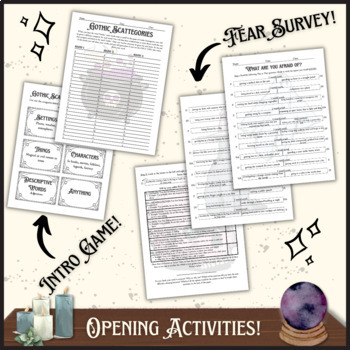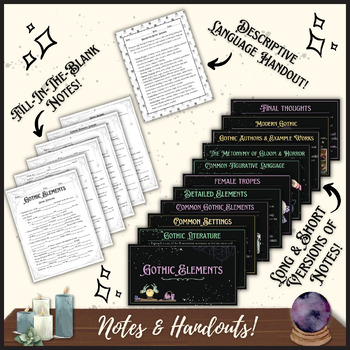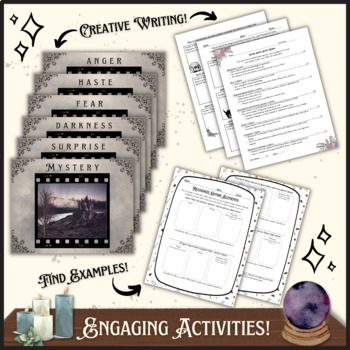Elements of Gothic Literature Bundle
Lit with Leah
18 Followers
Grade Levels
9th - 12th, Homeschool
Subjects
Resource Type
Standards
CCSSRL.9-10.2
CCSSRL.9-10.4
CCSSRL.9-10.5
CCSSRL.9-10.9
CCSSRL.9-10.10
Formats Included
- Zip
Lit with Leah
18 Followers
Products in this Bundle (3)
Bonus
Terms and Directions
Description
The Elements of Gothic Literature Bundle has everything you need to help your students dive deep into Gothic short stories! This bundle is meant to be paired with any Gothic short story you choose!
In this bundle you will find...
- 1 Fear Survey: (4 pages) Students will take an extensive survey to figure out which innate fear is the strongest in them! Once students have completed the fear survey, they will read about their fear and then answer reflective questions. This survey is a great tool to help students understand Gothic elements and how Gothic author evoke fear in their readers.
- 1 Gothic Scattegories Game: (2 pages) Activate your students' prior knowledge with this fun game! The students will receive a category and then work individually or in teams to come up with the words they relate to Gothic ideas. Use this tool to understand how much your students already know about Gothic literature and help them learn from each other!
- Elements of Gothic Literature PowerPoint:
- Version 1: This PowerPoint discusses Gothic Romanticism in-depth
- (19 slides) This Elements of Gothic Literature PowerPoint discusses What makes a story Gothic, Common Settings, Common Gothic Elements, Detailed Elements, Female Tropes, Common Figurative Language (metaphors, foreshadowing, similes, personification, dramatic irony), Metonymy, Gothic authors with Gothic story examples, and Modern Gothic examples
- Version 2: This PowerPoint provides a basic overview of Gothic Romanticism
- (13 Slides) This Elements of Gothic Literature PowerPoint discusses What makes a story Gothic, Common Settings, Common Figurative Language (metaphors, foreshadowing, similes, personification, dramatic irony) Metonymy, Gothic authors with Gothic story examples, and Modern Gothic examples
- Version 1: This PowerPoint discusses Gothic Romanticism in-depth
- Fill-in-the-Blank Notes for Students: Both PowerPoints come with their own set of fill-in-the-blank notes on the elements of Gothic Literature.
- Completed Teacher Notes: These help you move around the classroom without always looking at the screen, quickly review what students may have missed, and even provide the notes to students who are absent the day of the presentation. Both PowerPoints come with their own set of completed notes on the elements of Gothic Literature.
- 1 Descriptive Gothic Language handout: (1 page) This provides a list of Gothic adjectives to help students recognize and use effective descriptive Gothic language in their own Gothic short stories.
- 1 Identify Gothic Elements Activity: (2 pages) This provides examples of Gothic story ideas through media links. Students watch the videos and write down examples of Gothic elements that they recognize.
- 6 Printable Gothic Images: (6 pages) These Gothic images represent different emotions that are often used in Gothic short stories.
- 1 Gothic Writing Activity: (2 pages) The students will view the Gothic images for inspiration and then begin writing their own Gothic story ideas and sentences.
- 1 Gothic Short Story Rubric: (1 page) Once the students feel confident identifying and creating their own Gothic ideas, they can begin writing their own Gothic short stories! This rubric guides them through clear expectations of what they should include in their writing.
Looking for more bundles? Check these out!
Total Pages
Answer Key
N/A
Teaching Duration
1 Week
Report this resource to TPT
Reported resources will be reviewed by our team. Report this resource to let us know if this resource violates TPT’s content guidelines.
Standards
to see state-specific standards (only available in the US).
CCSSRL.9-10.2
Determine a theme or central idea of a text and analyze in detail its development over the course of the text, including how it emerges and is shaped and refined by specific details; provide an objective summary of the text.
CCSSRL.9-10.4
Determine the meaning of words and phrases as they are used in the text, including figurative and connotative meanings; analyze the cumulative impact of specific word choices on meaning and tone (e.g., how the language evokes a sense of time and place; how it sets a formal or informal tone).
CCSSRL.9-10.5
Analyze how an author’s choices concerning how to structure a text, order events within it (e.g., parallel plots), and manipulate time (e.g., pacing, flashbacks) create such effects as mystery, tension, or surprise.
CCSSRL.9-10.9
Analyze how an author draws on and transforms source material in a specific work (e.g., how Shakespeare treats a theme or topic from Ovid or the Bible or how a later author draws on a play by Shakespeare).
CCSSRL.9-10.10
By the end of grade 9, read and comprehend literature, including stories, dramas, and poems, in the grades 9-10 text complexity band proficiently, with scaffolding as needed at the high end of the range.By the end of grade 10, read and comprehend literature, including stories, dramas, and poems, at the high end of the grades 9-10 text complexity band independently and proficiently.





